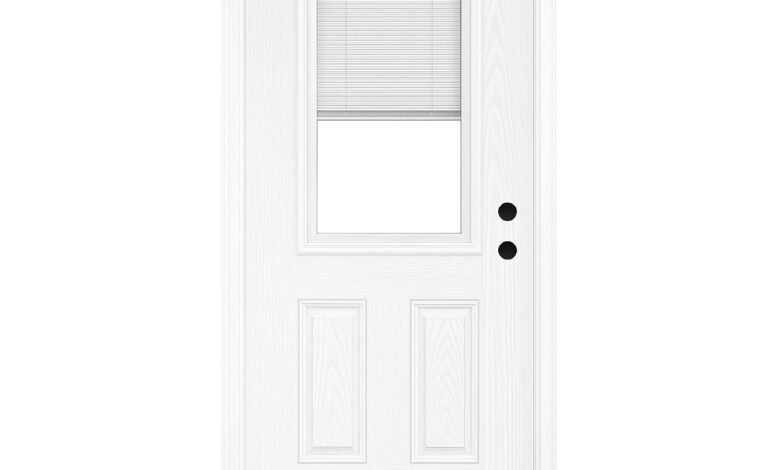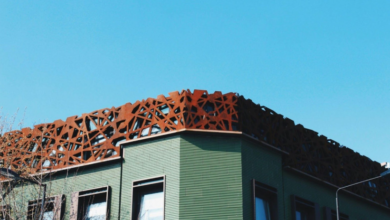Steel vs Fiberglass Doors: A Comprehensive Guide

Your entry door serves as the first line of defense against the elements while making a lasting impression on visitors. For homeowners planning upgrades and contractors managing multiple projects, selecting a door that balances durability, weather resistance, and aesthetic appeal is crucial. The right choice protects interiors from moisture damage, reduces energy costs, and withstands years of daily use without compromising performance.
When exploring an entry door collection, the decision often narrows down to steel versus fiberglass doors. Both materials offer high-quality construction and excellent moisture resistance, yet each brings distinct advantages that suit different applications. Steel doors provide unmatched security and affordability, while fiberglass options deliver superior insulation and design flexibility. Whether you’re installing a brickmould door for new construction or replacing an existing entryway, understanding how these materials perform in real-world conditions helps ensure you invest wisely. This guide breaks down the key differences to help you make an informed decision that aligns with your specific needs and budget.
Understanding Materials
Steel and fiberglass doors represent two fundamentally different approaches to entry door construction, each engineered to address specific performance requirements. Steel doors feature a metal skin wrapped around an insulating core, typically polyurethane or polystyrene foam. This construction creates a rigid, impact-resistant barrier that excels in security applications. The steel surface accepts paint finishes well and maintains structural integrity under stress, though it conducts temperature more readily than alternative materials.
Fiberglass doors consist of composite materials molded into realistic wood-grain patterns or smooth contemporary finishes. The material itself resists moisture absorption at a molecular level, preventing the swelling, warping, and rot that plague traditional wood doors. Fiberglass construction allows for intricate texturing and detailing that closely mimics natural wood species, offering design versatility without the maintenance burden. The material’s cellular structure provides inherent insulation properties while remaining dimensionally stable across temperature extremes. Understanding these fundamental material differences helps clarify how each door type performs in specific climate conditions and usage scenarios, setting the foundation for informed comparisons across durability, maintenance, and long-term value considerations.
Steel Doors
Steel entry doors deliver exceptional impact resistance that makes them ideal for high-traffic commercial applications and security-conscious residential installations. The metal construction withstands forceful impacts, attempted break-ins, and accidental collisions far better than wood or composite alternatives. A quality steel door with reinforced lock blocks and heavy-duty hinges creates a formidable barrier that deters intrusion while maintaining smooth operation through thousands of open-close cycles.
Modern steel doors incorporate advanced moisture-resistant treatments that address the material’s primary vulnerability. Manufacturers apply multi-layer primer systems and weather-resistant topcoats that seal the steel surface against rust and corrosion. The door’s core remains protected from moisture infiltration through weatherstripping and proper threshold installation. When properly finished and maintained, steel doors perform reliably in humid climates and coastal environments where salt air accelerates corrosion on unprotected metals. The edges and bottom rails require particular attention during installation, as exposed steel at these points creates pathways for moisture penetration.
The cost advantage of steel doors makes them particularly attractive for budget-conscious projects and multi-unit installations. Entry-level steel doors cost significantly less than comparable fiberglass units while still providing solid performance and security. This affordability extends beyond initial purchase price—steel doors accept standard hardware without specialized drilling requirements, and their widespread availability means replacement parts and compatible accessories remain readily accessible. For contractors managing tight budgets or homeowners seeking maximum security per dollar invested, steel doors deliver proven performance without premium pricing.
Fiberglass Doors
Fiberglass doors weigh considerably less than steel equivalents, simplifying handling during installation and reducing stress on hinges over the door’s lifespan. A typical fiberglass entry door weighs 30-40% less than a comparable steel unit, allowing single-person positioning during fitting and adjustment. This weight advantage proves particularly valuable in retrofit applications where existing frames may not support heavier door assemblies, and in second-story installations where maneuvering heavy materials presents safety challenges.
The material’s resistance to weather-related deterioration surpasses both steel and wood options across multiple environmental factors. Fiberglass does not rust, rot, split, or crack under normal use conditions. It maintains dimensional stability through seasonal humidity fluctuations that cause wood doors to swell in summer and shrink in winter. Coastal installations benefit from fiberglass’s immunity to salt-air corrosion, while doors facing direct sun exposure resist the UV degradation that fades and weakens lesser materials. The composite construction flexes slightly under impact rather than denting permanently like steel, allowing the material to absorb minor collisions without visible damage.
Superior thermal performance distinguishes fiberglass doors in energy-conscious applications. The material’s low thermal conductivity prevents heat transfer more effectively than steel, reducing the temperature differential between indoor and outdoor surfaces. This characteristic minimizes condensation formation on interior surfaces during cold weather and prevents the door from becoming uncomfortably hot to touch in direct sunlight. When combined with quality weatherstripping and a polyurethane foam core, fiberglass doors achieve R-values that contribute measurably to whole-house energy efficiency, particularly in climate zones with extreme seasonal temperature variations.
See also: Achieve Academic Excellence with Personalized At-Home Tutoring in Fremont
Installation and Maintenance
The installation process for steel and fiberglass doors follows similar basic steps—removing the old door, preparing the opening, setting the new unit, and adjusting for proper operation. However, the weight difference between materials significantly impacts labor requirements and timeline. Steel doors typically require two installers for safe handling and precise positioning, while fiberglass units often allow single-person installation in standard residential openings. Both door types work with existing brickmould frames in most retrofit situations, though shimming and leveling techniques vary based on the door’s weight distribution and flex characteristics.
Maintenance demands differ considerably between the two materials. Steel doors require periodic inspection of painted surfaces for chips or scratches that expose bare metal to moisture. Touch-up painting prevents rust formation and extends door life, particularly along bottom edges where water accumulation occurs. Fiberglass doors need minimal maintenance beyond routine cleaning—the material won’t rust or rot, and factory finishes resist fading and chalking for years without refinishing. Both door types benefit from annual hardware lubrication and weatherstripping inspection, but fiberglass eliminates the ongoing paint maintenance that steel doors demand in harsh climates.
Steel Doors
Installing a steel entry door requires standard carpentry tools including a level, drill with bits for pilot holes, shims, screws, and a reciprocating saw for trimming existing frames if necessary. A pry bar helps remove old units, while a caulking gun seals gaps around the new installation. The door’s weight necessitates a helper for positioning and holding the unit while checking level and plumb. Installation typically takes three to four hours for experienced installers working on a prepared opening with minimal adjustments needed.
Regular maintenance starts with annual inspection of the painted finish, looking for chips, scratches, or areas where moisture may penetrate to the steel substrate. Touch up damaged areas immediately with matching paint to prevent rust formation. Clean the door surface twice yearly with mild soap and water, avoiding abrasive cleaners that damage the finish. Lubricate hinges and locksets annually, and check weatherstripping for compression or gaps that compromise energy efficiency.
Fiberglass Doors
Fiberglass door installation requires the same basic toolkit as steel installations but benefits from the material’s lighter weight. One person can often handle positioning and initial fitting, though a helper still improves efficiency and accuracy. The reduced weight allows for easier adjustments during shimming and leveling. Installation time typically runs two to three hours for standard applications, with the lighter material allowing faster positioning and fewer breaks needed during the physical work.
Maintenance requirements remain minimal compared to steel alternatives. Clean fiberglass surfaces twice yearly with soap and water to remove dirt and environmental residue. The factory finish resists fading and doesn’t require repainting, though homeowners can refresh the appearance with appropriate exterior paint if desired. Inspect and lubricate hardware annually, and check weatherstripping for proper seal. The material’s resistance to moisture damage eliminates concerns about edge sealing and rust prevention that steel doors require.
Energy Efficiency
Energy efficiency directly impacts long-term operating costs and interior comfort levels, making it a critical factor in door selection. The insulation performance of entry doors is measured by R-value—higher numbers indicate better resistance to heat transfer. Steel and fiberglass doors both incorporate insulating foam cores, but the frame materials themselves conduct heat at different rates, affecting overall thermal performance. Steel’s high thermal conductivity creates a pathway for heat loss around the door’s perimeter, while fiberglass’s low conductivity minimizes this effect. In heating-dominated climates, superior insulation reduces furnace runtime and lowers utility bills. In cooling-dominated regions, better thermal performance keeps conditioned air inside while blocking heat gain. The door’s contribution to whole-house energy efficiency becomes particularly significant in open floor plans where the entry door faces living spaces directly, and in homes where the front door receives direct sun exposure for extended periods during peak heating or cooling seasons.
Steel Doors
Steel doors with polyurethane foam cores achieve R-values between 6 and 10, depending on door thickness and core density. This provides adequate insulation for most residential applications and represents a significant improvement over older hollow-core or solid wood doors. However, the steel skin itself conducts temperature readily, creating thermal bridging that reduces the door’s effective insulation value. In cold climates, this conductivity can cause interior condensation as warm indoor air contacts the cold steel surface. The thermal bridging effect becomes most noticeable around the door’s edges and lock area, where the steel frame transfers outdoor temperatures inward despite the insulating core.
Fiberglass Doors
Fiberglass doors typically achieve R-values between 8 and 12, outperforming comparable steel units by 20-30%. The composite material’s low thermal conductivity prevents heat transfer through the door skin itself, eliminating the thermal bridging that compromises steel door performance. This superior insulation maintains more consistent interior surface temperatures, reducing condensation risk and improving comfort near the entryway. The energy savings become measurable in extreme climates—a high-performance fiberglass door can reduce heating and cooling costs by 10-15% compared to a basic steel unit, with savings accumulating over the door’s 20-30 year lifespan to offset the higher initial investment. Manufacturers like Framewell have developed fiberglass door systems that maximize these thermal advantages through advanced core materials and precision-engineered weathersealing components.
Cost Considerations
The initial purchase price represents only one component of total door ownership costs, with maintenance expenses, energy savings, and replacement timing all contributing to long-term value. Steel doors typically cost 20-40% less than comparable fiberglass units at initial purchase, making them attractive for budget-constrained projects. However, the lower upfront investment comes with ongoing maintenance requirements and potentially higher energy costs that accumulate over the door’s lifespan. Fiberglass doors command premium pricing but deliver savings through reduced maintenance needs and superior energy efficiency. For homeowners planning to remain in their property long-term, the cumulative savings from lower heating and cooling bills can offset the higher initial investment within 8-12 years. Contractors managing rental properties or spec homes often prioritize lower acquisition costs, while custom home builders and energy-conscious homeowners increasingly view the premium as worthwhile for improved performance and reduced maintenance demands.
Steel Doors
Entry-level steel doors start around $200-400 for basic residential units, with mid-range options featuring better insulation and decorative glass panels running $500-800. This affordability makes steel doors the default choice for multi-unit projects and budget renovations. Long-term savings potential remains limited—while the doors provide adequate performance, their lower R-values result in higher energy costs compared to fiberglass alternatives. Maintenance expenses add up through periodic repainting requirements, with professional refinishing costing $150-300 every 5-7 years in harsh climates. The combination of modest energy performance and ongoing maintenance needs means steel doors rarely deliver significant long-term savings beyond their initial cost advantage.
Fiberglass Doors
Fiberglass doors typically range from $600-1,200 for standard residential units, with premium designs featuring authentic wood-grain textures and decorative glass reaching $1,500-2,500. This higher initial investment pays dividends through superior energy efficiency that reduces heating and cooling costs by $75-150 annually in extreme climates. Minimal maintenance requirements eliminate periodic refinishing expenses, saving $150-300 every few years compared to steel door upkeep. Over a typical 25-year lifespan, these combined savings can total $3,000-5,000, effectively recovering the initial price premium while delivering better performance and appearance throughout the door’s service life.
Making the Right Choice for Your Home
Steel and fiberglass doors each serve distinct needs in residential and commercial applications. Steel doors excel in security-focused installations where impact resistance and affordability take priority, making them ideal for rental properties, budget renovations, and high-traffic commercial entrances. Their lower initial cost and proven durability deliver solid value when upfront budget constraints outweigh long-term operating expenses. Fiberglass doors justify their premium pricing through superior energy efficiency, minimal maintenance demands, and exceptional weather resistance that proves particularly valuable in extreme climates and coastal environments.
Your specific circumstances should guide the final decision. Choose steel when immediate cost savings matter most and you’re prepared to handle periodic maintenance. Select fiberglass when energy efficiency, low maintenance, and long-term value align with your priorities. Consider your climate zone, exposure to harsh weather, planned ownership duration, and available maintenance resources. Whether you’re selecting doors from an entry door collection for new construction or replacing existing units with brickmould door assemblies, matching material properties to your actual requirements ensures satisfaction throughout the door’s 20-30 year service life. Both materials deliver reliable performance when properly installed and maintained—the right choice simply depends on which benefits matter most for your application.




